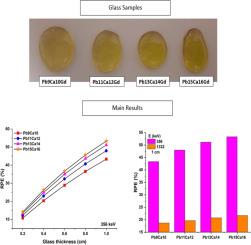Correlated experimental and theoretical study of PbO2BaO-CaO-B2O3Gd2O3 glasses with varying PbO2/CaO ratios for gamma-radiation protection
IF 5.7
3区 材料科学
Q2 MATERIALS SCIENCE, MULTIDISCIPLINARY
引用次数: 0
Abstract
This study investigates the PbO2-BaO-CaO-B2O3-Gd2O3 glass system, focusing on how varying PbO2/CaO composition ratios influence gamma-radiation shielding performance. The combined FTIR and XRD results establish that the samples retain their amorphous nature while undergoing significant short-range structural modifications. Both experimental measurements and theoretical modelling using Phy-X/PSD software were employed to assess mass attenuation coefficients (GMAC), linear attenuation coefficients (GLAC), half-value layer (GHVL), mean free path (GMFP), transmission factor (TF), and radiation protection efficiency (RPF) across gamma energies of 356, 511, 661.7, 1173.2, 1274.5, and 1332.5 keV. Experimental GMAC values closely aligned with theoretical data, with deviations under 6 %, validating the experimental approach. The present study outcomes reveal that increasing PbO2/CaO content enhances gamma shielding by raising density and photon interaction, with Pb15Ca16 showing superior attenuation, lowest HVL, TF and RPE above 50 % at 1 cm for 356 keV. These findings highlight Pb15Ca16 as a promising candidate for radiation shielding applications.

不同PbO2/CaO比的PbO2BaO-CaO-B2O3Gd2O3玻璃对γ辐射防护的相关实验与理论研究
本研究研究了PbO2- bao -CaO- b2o3 - gd2o3玻璃体系,重点研究了PbO2/CaO组成比对γ辐射屏蔽性能的影响。FTIR和XRD的综合结果表明,样品在经历了显著的短期结构修饰后仍保持其非晶性质。利用Phy-X/PSD软件进行实验测量和理论建模,评估了356,511,661.7,1173.2,1274.5和1332.5 keV伽马能量下的质量衰减系数(GMAC),线性衰减系数(GLAC),半值层(GHVL),平均自由程(GMFP),透射系数(TF)和辐射防护效率(RPF)。实验GMAC值与理论值吻合较好,偏差小于6%,验证了实验方法的正确性。本研究结果表明,PbO2/CaO含量的增加通过提高密度和光子相互作用来增强伽马屏蔽,Pb15Ca16表现出优异的衰减,在356 keV下,1 cm处的HVL、TF和RPE均在50%以上。这些发现突出了Pb15Ca16作为辐射屏蔽应用的有前途的候选者。
本文章由计算机程序翻译,如有差异,请以英文原文为准。
求助全文
约1分钟内获得全文
求助全文
来源期刊

Materials Research Bulletin
工程技术-材料科学:综合
CiteScore
9.80
自引率
5.60%
发文量
372
审稿时长
42 days
期刊介绍:
Materials Research Bulletin is an international journal reporting high-impact research on processing-structure-property relationships in functional materials and nanomaterials with interesting electronic, magnetic, optical, thermal, mechanical or catalytic properties. Papers purely on thermodynamics or theoretical calculations (e.g., density functional theory) do not fall within the scope of the journal unless they also demonstrate a clear link to physical properties. Topics covered include functional materials (e.g., dielectrics, pyroelectrics, piezoelectrics, ferroelectrics, relaxors, thermoelectrics, etc.); electrochemistry and solid-state ionics (e.g., photovoltaics, batteries, sensors, and fuel cells); nanomaterials, graphene, and nanocomposites; luminescence and photocatalysis; crystal-structure and defect-structure analysis; novel electronics; non-crystalline solids; flexible electronics; protein-material interactions; and polymeric ion-exchange membranes.
 求助内容:
求助内容: 应助结果提醒方式:
应助结果提醒方式:


